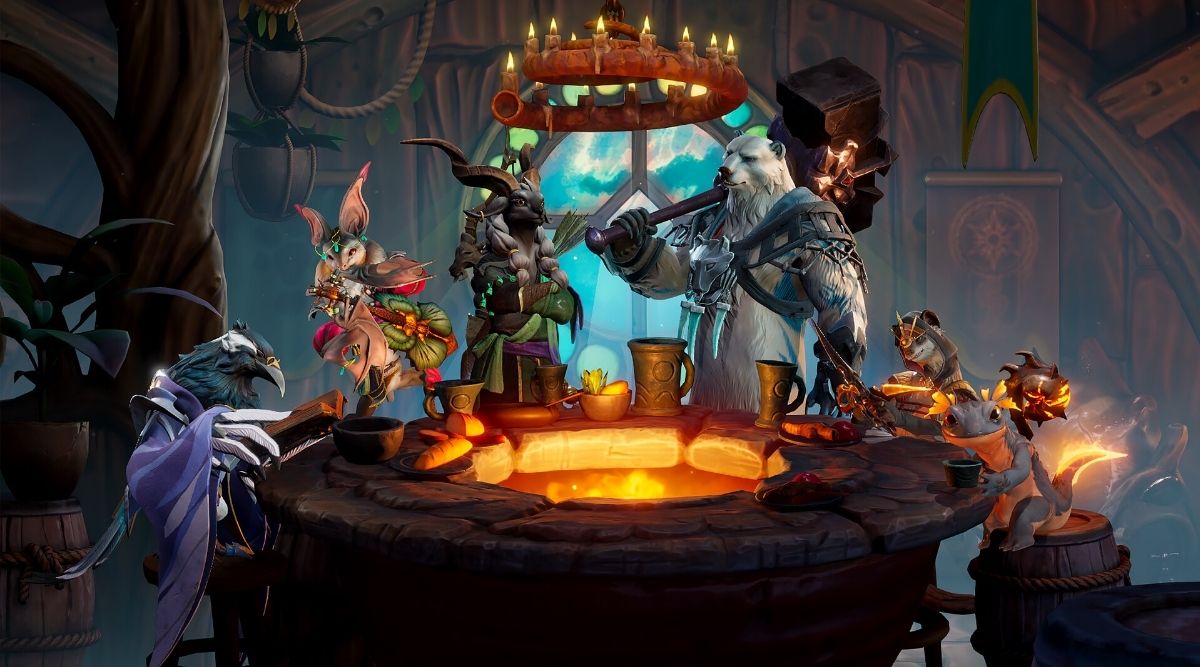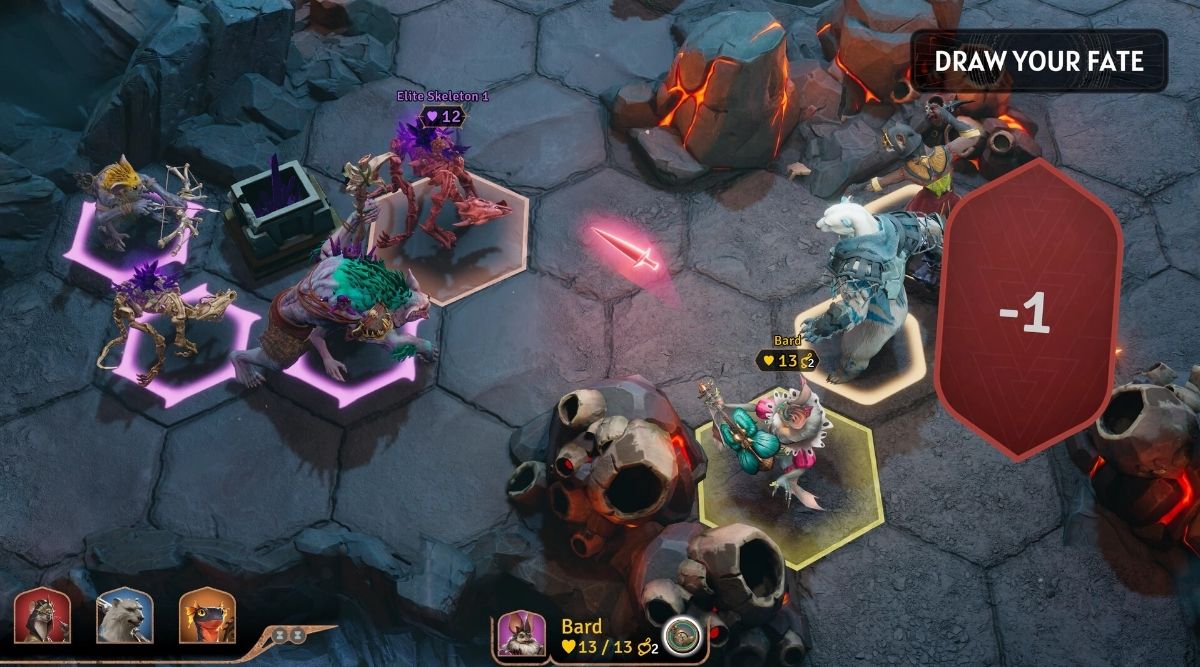When I first booted up Sunderfolk, I didn’t expect to find myself guiding my wife through a spell combo or streaming to an old friend on Steam. I definitely didn’t expect to be streaming to TTRPG-curious friends halfway across the country—and then, later, playing as a silent fifth player while four friends with wildly different backgrounds clicked into a rhythm that felt like we’d been playing together for years.
But that’s the magic of Sunderfolk—it’s a game that doesn’t just invite different kinds of players. It supports them, teaches them, and celebrates the moments where they make it their own. And that level of approachability, depth, and intention isn’t an accident. It’s the result of deeply considered, player-first design from a team that’s been building across tabletop, PC, and console spaces for years.
We talked to Erin Marek and Chris Sigaty, two of the leads behind Sunderfolk, to find out how this game ended up being just as friendly to your “forever DM” as it is to the friend who doesn’t own Steam and has never touched a tactics game before. And the answer? It’s heart. All the way down.
When I told the team I’d been playing Sunderfolk on hotel Wi-Fi in Japan, Steam Share with friends, couch co-op with my wife, and even through Discord screenshare, they weren’t surprised. “Maybe counter to what you’re saying, our intent was always to couch co-op as the best version of the game,” Erin said. “When I first joined the studio, I actually drove into the studio to play the game for the first time because it was so important that we were in that in-person environment.”
Sunderfolk was designed to be played together in person.

That in-person design ethos carried over—even as remote play and streaming options became essential during development. “We had to build some of that functionality, even just for us to test and playtest the game,” Erin explained. “Because it was a necessity of our development… we ended up building a lot of it in. Never at the cost of the couch co-op experience, but always hopefully in supplement to it.”
Chris jumped in to emphasize what’s still core: “There is something magical about the in-person experience where it allows for more laughter and fun, just in general. And if people can make that happen in their lives and our game can be one reason to do it, then we’re winning as far as we’re concerned.”
And they really did account for the weird edge cases. “I bring my Switch everywhere I go,” Erin added. “I take it to family vacations and stuff. And it’s been a huge way that I share some of the games that I love with friends and family. So for me, it was also like, hey, can we hit this weird edge case? And maybe that’ll cover a lot of the other less weird ones.”
I told them about getting destroyed in Shadowstone solo, the game’s hardest difficulty. About how I still felt like it was my fault, not the game’s. That sense of fairness? That’s intentional, too. “One of our high-level pillars of the game was the strategy,” Erin explained.
“But a sub-pillar under that was that your choices will always impact the success.” So when the game gets harder, it’s not just stat inflation. “We really tried to lean into other means of making you feel like the monsters are stronger, but they’re still the same monsters,” Erin said. “Because it’s so much harder, you have to think a little bit differently about your abilities.”
Sunderfolk isn’t meant to punish experimentation.

Chris elaborated: “There’s a lot that goes into it with how you’re prepping your character and your fate deck, what ability cards you’re bringing, and the comp of your group at that particular moment.” And Sunderfolk doesn’t punish experimentation, but it does ask you to engage. “When we got up to Shadowstone difficulty,” Chris said, “We kind of said, look, there are going to be comps that don’t work on some of these missions and are going to be hard. And that’s okay.”
Key to the higher challenges is Frenzy, a mechanic Chris described as “The mode that sits on top of it where every time you strike a monster, it frenzies up… [and] if monsters don’t get attacked or don’t get a chance to attack you, they also frenzy.”
If that sounds intimidating, it’s because it is. But the devs built Sunderfolk with modularity in mind. “A lot of those [difficulty modifiers] have settings you can kind of turn on and off,” Erin added. “Because there’s such a wide potential of who’s playing this game… we want all the hard settings on, we want to turn them all off. And maybe if we lose a mission too many times, we’re like, maybe we turn a couple of these things down just for this mission to get through.”
I laughed with them about a friend who didn’t own Steam—and yet had a great time via Discord. That wasn’t an accident either. “From the very beginning, one of our main things we were looking at is making an inviting experience,” Erin said. “And I think often, people think about that as people who have never played games like this… but inviting experience is really about anybody who might possibly want to play this game.”
This isn’t just about accessibility—it’s about anticipating diverse playgroups. “You look at a bear, and you’re like, yeah, it could probably take a big hit,” Erin explained. “You might not know what a berserker is, but you probably get an idea that it’s going to get angry and hit things harder.”
Chris echoed this adaptive philosophy. “We try to make the dynamics of the group drive what happens and try to support it as best we can,” he said. “Other places this happens, that’s not about the difficulty of the game, it’s also things like being in town and talking to NPCs.”
He continued, “Generally, what we found is every group is a mix. You never find a group that’s like all the NPC deep divers or all the hardcore people.”So what happens? “Groups tend to sort of self-regulate in a good way,” Chris said. “And that’s a big part of this—there had to be something here that allowed the core tactics board gamer to find fun, but also allow that person to be along for the ride.”
A fifth player can gladly just use their phone to be part of the game.

As someone who plays a lot of games, but often ends up guiding others, I told them about the moment Sunderfolk became my favorite party trick. “I think I had the most fun playing with my four friends and streaming, and then letting all four of them play,” I said. “I didn’t control any characters. I just told people how to play the game, and let them see how we did it.”
Erin immediately got it. “I am also a forever DM, so I am glad to hear that’s your experience as well,” she said. “There’s some amount of joy you get just from being there to support people playing.” And that feeling translated to Sunderfolk seamlessly. “It still has a lot of those board game-y elements,” Erin added. “You’re kind of getting this at a higher level, and there’s a joy in watching people play through it and socialize and have a good time.”
Chris highlighted one of the team’s favorite playtest moments: “We had five people and only four characters in a mission, and they would just naturally, unprompted, hand the phone to that fifth person. It really worked well in those cases, and it was completely natural.”
The game constrains enough to make learning possible. “The amount of context you have to give [as a coach] can sometimes be so big that they’re already starting to shut down mentally,” Chris explained. “But because the video game aspect puts those confines up… it enables that player to feel confident to go in and play.”
I asked if the team had ever considered building a spectator or “fifth-player” mode to give hosts more visibility. “I love that feedback,” Erin said. “We’ve been exploring a lot of different features, anything from something more like that all the way down to maybe even slightly weirder things.”
And while no feature was confirmed, Erin left the door open: “As we look at the post-launch and are getting feedback from players, I think that’ll help us narrow down where we want to spend the time and focus.”
Sunderfolk is flexible enough to support all kinds of players.

What really makes Sunderfolk shine, though, is that the design is flexible enough to support different kinds of play—whether you’re optimizing damage output or spawning fire just because it looks cool.
“One of my favorite things that I witnessed in one of the playtests was Pyromancer spawning fire so that the Berserker could walk into it and get rage and then kill something,” Erin shared. She laughed about her own unorthodox strategies. “I’ll play the Berserker or Bard or something and be like, all I’m doing is spawning a ton of fire and walking on it and killing people. It’s not optimal, but it’s super fun.”
Chris shared one of his favorite player stories—about a dad and daughter who struggled, failed, and came back the next day with a new strategy. “It’s not exactly a different way of solving it,” he said, “But it’s even in defeat—if you walk away thinking about the problem and then can come up with solutions, I think that’s a real advantageous thing.”
When I asked about Sunderfolk on Switch 2, Chris smiled. “We love Nintendo. Switch is a big focus,” he said. “We spend a lot of time making the game run on Switch… but we don’t have a 100 percent answer on [Switch 2] just yet. We’re anxious to learn more.”
And what about the team itself—what did they learn? Erin reflected on the scope. “They always tell you: don’t have new tech, new IP, new team, new game, and innovation all on the same project,” she laughed. “And we kind of did all of that.”
But they pulled it off. “We were so much more capable than I think I was expecting,” Erin said. “And maybe on a slightly more personal step… I just really love turn-based games. I’ve played them for a very long time. I’m so ready for this to launch so I can go and play it with my friends.”
Chris agreed. “I’ve never gotten to the end of a project and not felt like there’s so much we could improve,” he said. “But in the greater scheme of things, we’re launching a game that I’m extraordinarily proud of.”
And it shows. In every mushroom-folk conversation, every customizable difficulty slider, every shared turn between friends, you feel it. Sunderfolk isn’t just a tactics game. It’s an invitation. And we’re all welcome.
Sunderfolk is available now on PC, PlayStation 5, Switch, and Xbox Series X|S.



![[EXCLUSIVE] Palia Devs Dive Into Winterlights, New Tints, Lunar Paths, And More From Upcoming Patch Palia Winterlights Patch](https://butwhytho.net/wp-content/uploads/2025/12/Palia-Winterlights-But-Why-Tho-450x247.jpg)



